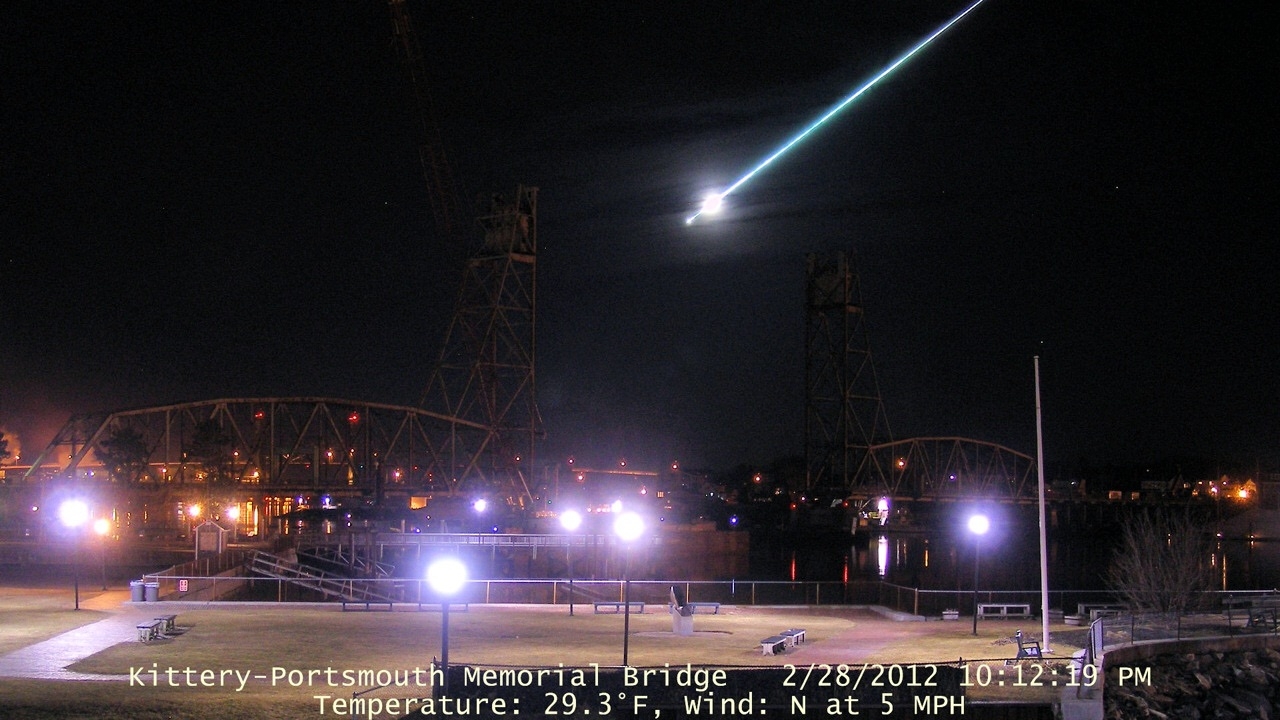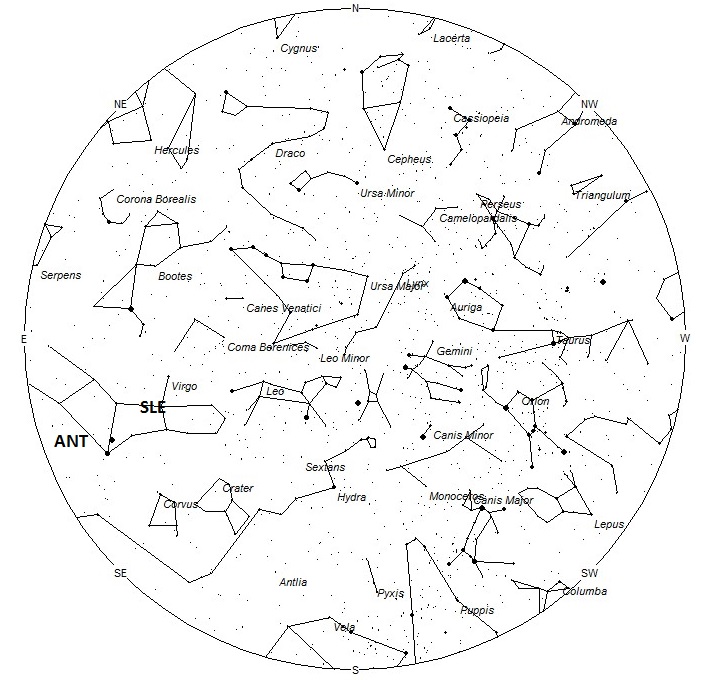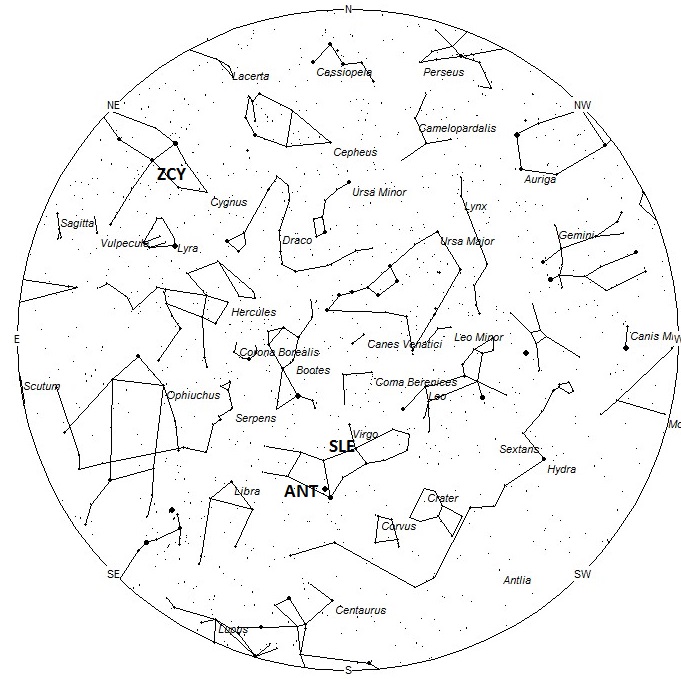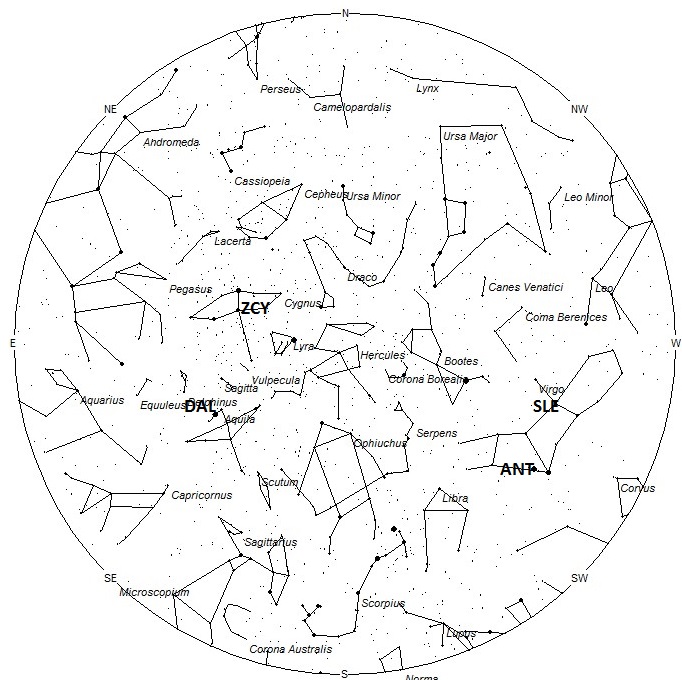
Photo shared on the American Meteor Society’s website – ©Mike McCormack – 2012-02-28 22:12:19 EST – Ams Event #303-012
During this period the moon reaches its full phase on Saturday April 4th. At this time the moon will be in the sky all night long and will spoil attempts to view meteor activity. As the week progresses the moon’s phase will wane but it will still rise before midnight and will spoil viewing for the more active morning hours. The estimated total hourly meteor rates for evening observers this week is near 1 for observers situated at mid-northern latitudes and 3 for observers viewing from the southern tropics (latitude 25 S.). For morning observers the estimated total hourly rates should be near 4 for observers situated at mid-northern latitudes and 6 for observers viewing from the southern tropics. Rates are reduced during this period due to moonlight. The actual rates will also depend on factors such as personal light and motion perception, local weather conditions, alertness and experience in watching meteor activity. Note that the hourly rates listed below are estimates as viewed from dark sky sites away from urban light sources. Observers viewing from urban areas will see less activity as only the brightest meteors will be visible from such locations.
The radiant (the area of the sky where meteors appear to shoot from) positions and rates listed below are exact for Saturday night/Sunday morning April 4/5. These positions do not change greatly day to day so the listed coordinates may be used during this entire period. Most star atlases (available at science stores and planetariums) will provide maps with grid lines of the celestial coordinates so that you may find out exactly where these positions are located in the sky. A planisphere or computer planetarium program is also useful in showing the sky at any time of night on any date of the year. Activity from each radiant is best seen when it is positioned highest in the sky, either due north or south along the meridian, depending on your latitude. It must be remembered that meteor activity is rarely seen at the radiant position. Rather they shoot outwards from the radiant so it is best to center your field of view so that the radiant lies at the edge and not the center. Viewing there will allow you to easily trace the path of each meteor back to the radiant (if it is a shower member) or in another direction if it is a sporadic. Meteor activity is not seen from radiants that are located below the horizon. The positions below are listed in a west to east manner in order of right ascension (celestial longitude). The positions listed first are located further west therefore are accessible earlier in the night while those listed further down the list rise later in the night.
These sources of meteoric activity are expected to be active this week. Details on each source will continue next week when the situation with moonlight will be more favorable.
| SHOWER | DATE OF MAXIMUM ACTIVITY | CELESTIAL POSITION | ENTRY VELOCITY | CULMINATION | HOURLY RATE | CLASS |
| RA (RA in Deg.) DEC | Km/Sec | Local Daylight Saving Time | North-South | |||
| Sigma Leonids (SLE) | Apr 16 | 13:04 (196) +03 | 19 | 00:00 | <1 – <1 | IV |
| Anthelions (ANT) | – | 13:52 (208) -11 | 30 | 01:00 | 2 – 2 | II |
| Zeta Cygnids (ZCY) | Apr 06 | 20:08 (302) +40 | 40 | 07:00 | <1 – <1 | IV |
| Delta Aquiliids (DAL) | Apr 10 | 20:12 (303) +10 | 63 | 07:00 | <1 – <1 | IV |
 American Meteor Society
American Meteor Society



Kinda odd how I found this site. I am a person who is in awe about space in general and all that goes with its amazement! I have no telescope but still love to look up hoping to see what the night has to offer. Other than viewing a comet in the early 90’s the best thing I’ve seen personally was the transit of Venus in 2012, thankfully I had a welding shield and cutting glasses to look at it with my own eyes and it was amazing for being so small in comparison to the sun! Id like to get information on becoming a member if possible. Thank you
Yes it is possible to see fireballs while it is still daylight. The brightest fireballs can exceed the brightness of the moon, which is easily seen during the day.
You can join us here: http://www.amsmeteors.org/members/user/register/
Robert Lunsford
American Meteor Society
On my way into work this morning, Agoura Hills CA. Spotted what looked to be a meteor. It was whole and then broke off into smaller and smaller segments. This was about 6:04am PST. I thought it was a small airplane flying very low at first until I noticed it broke into smaller parts.